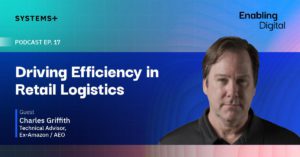How is data revolutionizing the retail industry and 5 use cases of BI in retail

The retail industry is one of the largest sectors in the world and is expected to grow as the middle classes are increasing substantially in size and in buying power. Retail purchases via ecommerce and m-commerce are growing at a high rate due to the advent of high-speed internet connections, advancements in Smartphone technology and online-related technology, improvements in the product lines of e-commerce firms, a selection of delivery options and better payment options.
The advent of big data in retail industry represents a cultural shift in the way retailers connect with consumers in a meaningful way. This bottom-line impact of big data is what makes it a business imperative and why retailers around the world are leveraging it to transform their processes, their organizations and, soon, the entire industry.
As consumer technology adoption and multi-channel shopping experiences become the norm, data becomes increasingly critical.
Retailers who use customer data to transform themselves are better positioned to thrive and create sustainable growth in the new digital retail landscape.
Below is a set of defined use cases designed to drive value through more effective application of customer data.
By doubling down on the customer experience, retailers can thrive by leveraging your physical stores to deliver a powerful, personalized experience.
The key is to create a unique shopping experience where customers derive both value and pleasure from visiting physical storefronts.
It is important to collaborate with merchandising teams to understand the merchandising strategy and the key metrics for improvement. Review data, identify opportunities to drive improvement, and develop hypotheses for how to enhance the customer shopping experience.
Thanks to advances in IoT and edge-computing, we are seeing more devices being placed in stores to monitor traffic.
Companies like RetailNext are leading the charge on such solutions and helping retailers through a variety of use-cases. Operations teams can measure traffic accurately and optimize staffing to reduce costs or improve the shopper experience. Marketers can measure the impact of certain campaigns through trends in traffic and areas of the store that have been visited. Merchandising teams can understand the impact of their assortment choices and display products accordingly. Products can be placed optimally to drive conversion. Finally, retailers can change the entire store design to optimize traffic, assortment, and conversion.
Almax has created “smart mannequins” that consist of cameras for eyes and analyze shoppers’ faces to detect age, gender, ethnicity, and multiple other characteristics. A luxury goods retailer is currently piloting their technology to better assess their marketing messages, potentially discover new target groups, and tune their in-store displays.
NEC has built a similar system called NeoFace that can alert staff when a loyal customer or a big spender walks into a store.
Building an effective personalization program will help accelerate the retailer’s progress toward results: a more personalized experience, greater customer loyalty, increased wallet share, and substantially better top and bottom lines.
Engaging a customer at the right place at the right time with the right offer is the holy grail for marketers.
Tracking the customer journey allows to serve the most relevant product and content recommendations based on a customer’s shopping, browsing and transaction history.
A global e-commerce platform, EMEA, wanted to expand its product recommendation capabilities across its many product verticals. The retailer spent 12‑18 months aggregating all customer data across verticals to create a single view of customers’ browsing and purchasing patterns. The retailer ran A/B tests on the customer data and developed an algorithm to drive continuous improvement in recommendation accuracy. This resulted in a 500% increase in sales conversion in some of the retailer’s product lines.
We’re primarily seeing this sort of omni-channel journey orchestration possible in customer data platforms (CDPs) and modern marketing automation tools.
Marketing automation tools like Braze and Salesforce Marketing Cloud allow marketers to create journeys based on a variety of events such as API triggers, time-based triggers, data changes and more. These journeys can then span multiple days and dynamically adapt messaging based on customer data being fed into the system during the journey lifespan. Imagine getting a thank you e-mail for a product you purchased and then getting recommendations for other similar products a few days later, only to receive a promotion after that for being a loyal customer and writing a product review on the site.
Supercharging these marketing automation tools, are CDPs which have the power to ingest unlimited amounts of data and produce personalized customer recommendations. CDPs can ingest numerous sources of customer data to create a consolidated Customer 360 view. They then enhance that view with machine learning models to figure out likelihood to churn, propensity to buy, recommended products and more. These insights can then be used in audience creation during the journey building process, and ultimately activated via marketing automation tools, advertising, Connected TV and website personalization.
Assortment planning is a lengthy and complex process that occurs before major seasons. The volume of information that needs to be collected, analyzed and acted upon becomes incredibly difficult to process manually. Legacy assortment management suites would just put a UI on top of this process, but that is no longer enough. Modern assortment management uses data to take the guesswork out of planning and drive higher sales with better product breadth and depth. They reduce excess inventory and can keep additional stock for high selling items.
Stores are no longer clustered and graded based on revenue, but on a variety of factors such as store size, location, revenue, and more. Modern systems can also help you forecast the success of new products that plan on being introduced.
Analyze customer purchasing behavior to help inform future product catalog and web placement decisions.
Below are the four steps to activate this use case after developing your data foundations.
1) Collect data:
Identify data elements created by customers on your owned and operated websites, stores. Browsing and purchasing data are two key data sets as they indicate what customers are looking at and what they respond to. Develop and document a data strategy that defines the first-party data you will collect and sets integration goals for data collection and management efforts.
2) Build Segments:
Analyze your data to reveal customer insights. Focus segmentation and targeting efforts on grouping customers based on common characteristics, such as the products they browse and buy, traffic source, or basket size. The critical element is to uncover the characteristics that will influence your product assortment, product hierarchy, and merchandising decisions.
3) Develop and run tests:
The data team and product assortment and merchandising team need to collaborate to perform A/B testing of the different levers (e.g., layouts, product categories) across the different segments. Tests should be conducted live and continuously to constantly refine your design decisions and drive incremental value.
4) Implement changes and iterate:
Use the insights gained from A/B testing to inform new decisions about product hierarchy, layout, and range, as well as how to most effectively tailor these elements for each customer. For some retailers, merchandising includes content planning to inspire customers who do not yet know what they are looking to purchase.
By improving their ability to deliver the right merchandise assortments to the right outlets
at the right price and manage their inventories to these data-driven consumer demand signals, retail organizations are better positioned to seize market opportunities by delivering
new customer-centric products at more predictable costs.
We live in an era in which smart pricing strategies can catapult new brands and retailers to quick success. At the same time, failure to project the right price image can seriously undermine the prospects of businesses
Think of Dollar Shave Club, an e-commerce subscription start-up that grew rapidly on the promise of providing “a great shave for a few bucks a month.” And then, of course, there are widely admired brands such as Apple, Patagonia, American Eagle and Lululemon that have largely avoided discounting based on the merits of their product quality. As these examples demonstrate, price plays an important role in establishing the brand image and what it stands for. A brand that dependably connects with shoppers through its price message is typically a brand that enjoys long-lasting customer loyalty.
As complex as pricing analytics may seem, managing a brand’s price position is crucial to the way it is perceived by consumers.
Industry leaders are adopting cutting-edge AI tools to stay competitive and incorporate a dynamic pricing strategy. These tools and platforms utilize price analysis data from various channels of a company’s operations (i.e., marketing channels, logistics channels, eCommerce platforms). Thus, it empowers retailers to make data-driven competitive pricing decisions while receiving a better ROI on each product.
The customization of a recommended price should be dictated by the retailer’s:
Pricing analytics can play a key role in bypassing the need for a MSRP and help create customized recommended prices. A good example of a retailer using intelligent application of pricing analytics is Amazon, which makes over 2.5 million price changes per day, often changing the price of a single item several times within 24 hours.
Pricing analytics allows companies to create a mechanism that acts as a catalyst for managing profitability. That term alone — managing profitability — is telling. With predictive analytics, marketers find themselves increasingly in the driver’s seat, making discreet judgments on how much margin to reserve on particular products relative to the competitive situation.
Product recommendations and promotions
Retailers need to serve the most relevant product and content recommendations for the online journey based on a customer’s browsing and transaction history.
Leading retailers who excel in product recommendations exhibit the below common characteristics that enable them to succeed with this use case.
1) Culture: Ability to balance business objectives and customer insights to recommend the right product to the right customer at the right time while driving a commercial outcome.
2) Tech: Data is aggregated into a standard repository to provide a single view of the customer. Machine Learning is used to effectively analyze large volumes of data.
3) Skills: Collaboration between data and merchandising teams to constantly optimize product
Skills recommendations.
4) Data: Access rich data on product performance and product relationships to feed into complementary Tech Data and substitute algorithms.
Common Challenge: Alignment with Promotional Planning Process
Retailers express a common challenge in aligning segmentation and targeting efforts with
promotional teams, given promotion timelines may extend months in advance of an event and
optimal targeting efforts require near-real time responses. To bridge this gap, include the data,
sales, marketing, and merchandising teams in long-term planning sessions.
With a huge growth in online sales during the pandemic, we are also seeing a big surge in fraudulent transactions.
Fraud can be a pressing challenge for the retail industry, with the potential to impact finances, erode customer trust, and impact brand value. Consumer market companies tend to have several third-party touchpoints, such as vendors/ suppliers, transporters, third-party manufacturers or subcontractors, packers, distributors or other third-party service providers, which can significantly increase the risk of collusive frauds that are difficult to detect.
Having a team manually review each fraudulent transaction isn’t scalable; this eventually leads to numerous customer service complaints and an overall decline in brand recognition. Companies like Forter have built machine learning models that use past transaction history data to easily identify fraudulent transactions and prevent unnecessary loss of revenue due to chargebacks. The reduction in chargebacks automatically drives down customer service complaints and frees up time for resources to work on more important things.
To compete in a consumer-empowered economy, it is increasingly clear that retailers must leverage their information assets to gain a comprehensive understanding of markets, customers, products, distribution locations, competitors, employees, and more.
Retailers will realize value by effectively managing and analyzing the rapidly increasing volume, velocity, and variety of new and existing data, and putting the right skills and tools in place to better understand their operations, customers, channels, and the marketplace as a whole.
Finding the right external partner to help develop the digital transformation program is important, too, and will help accelerate the retailer’s progress toward achieving business objectives.






